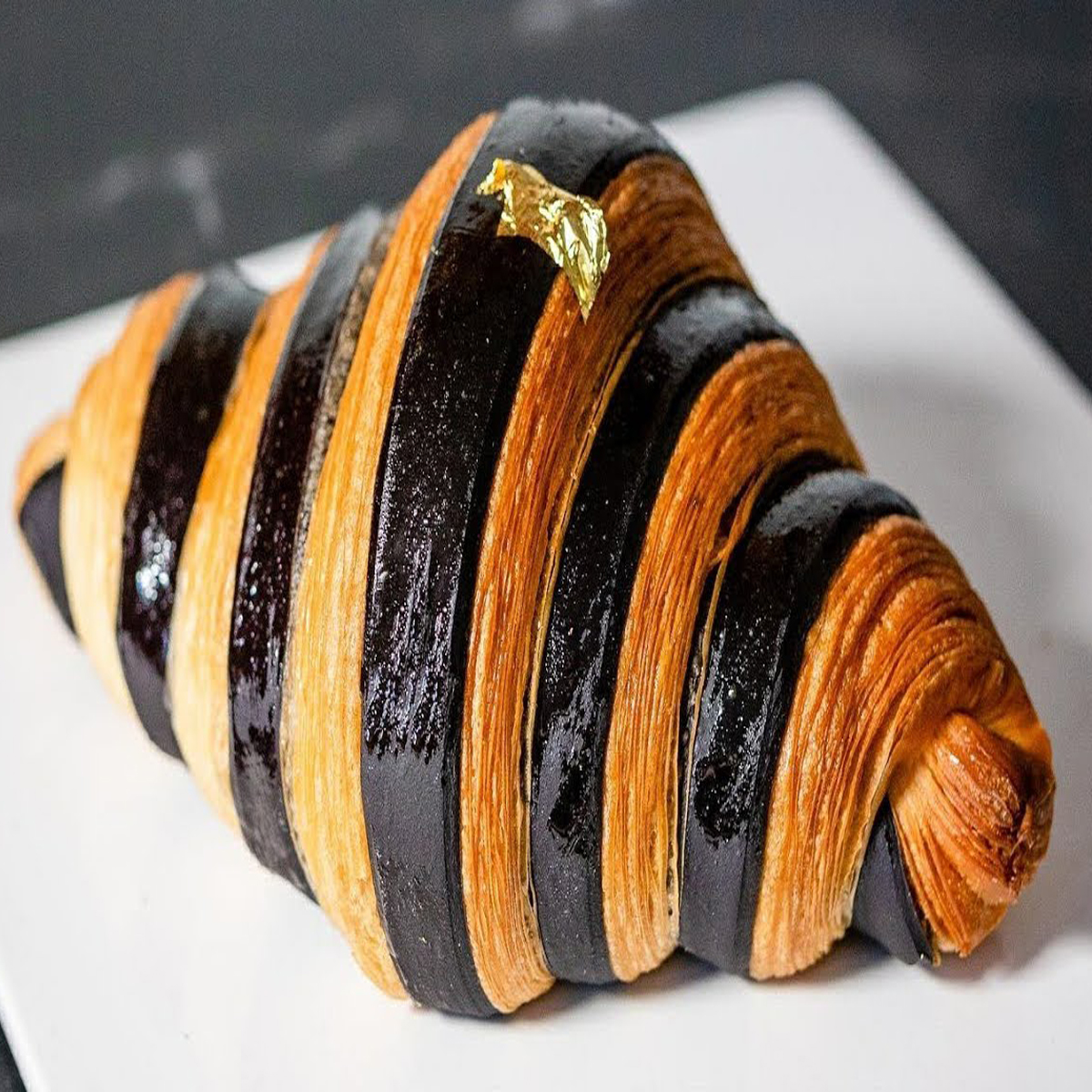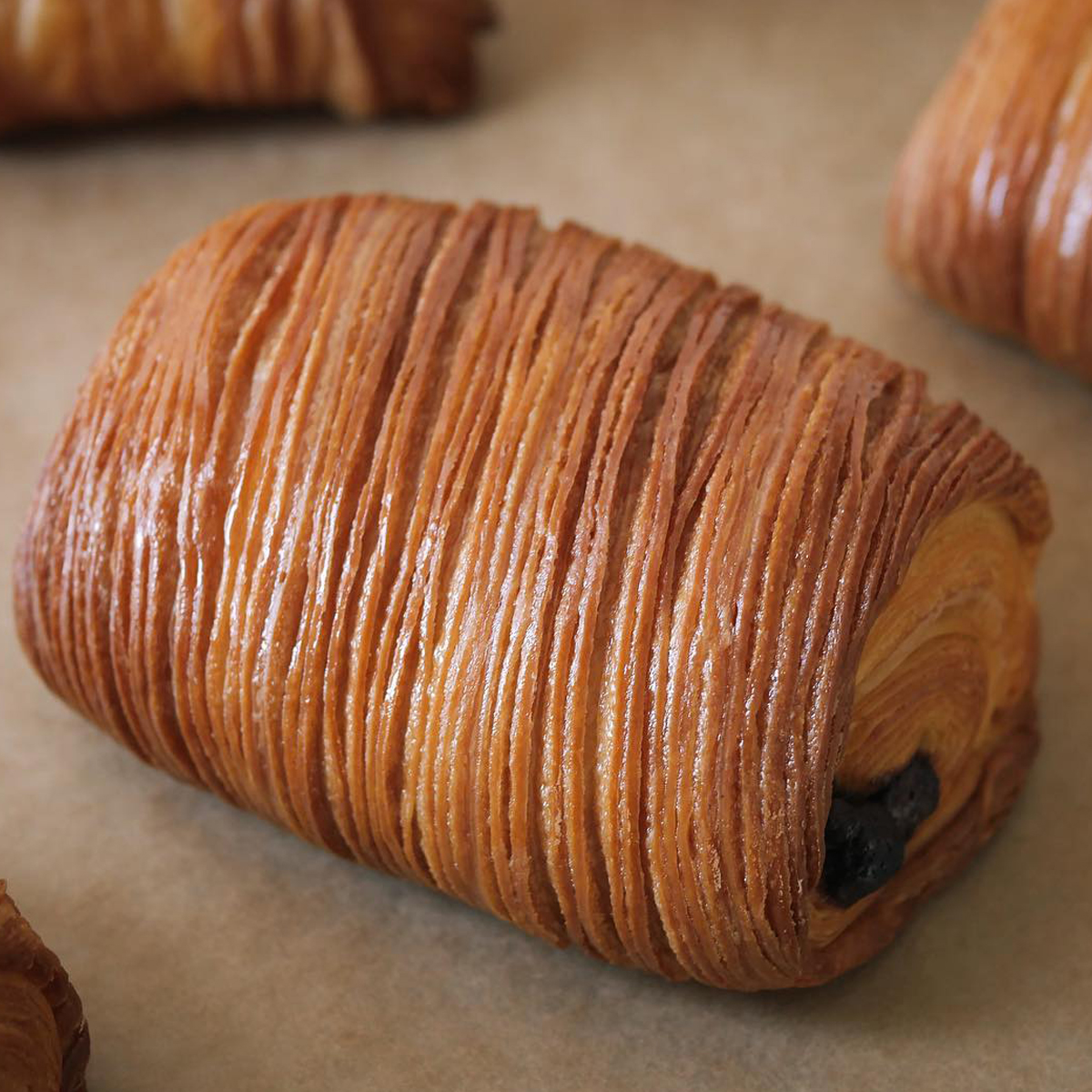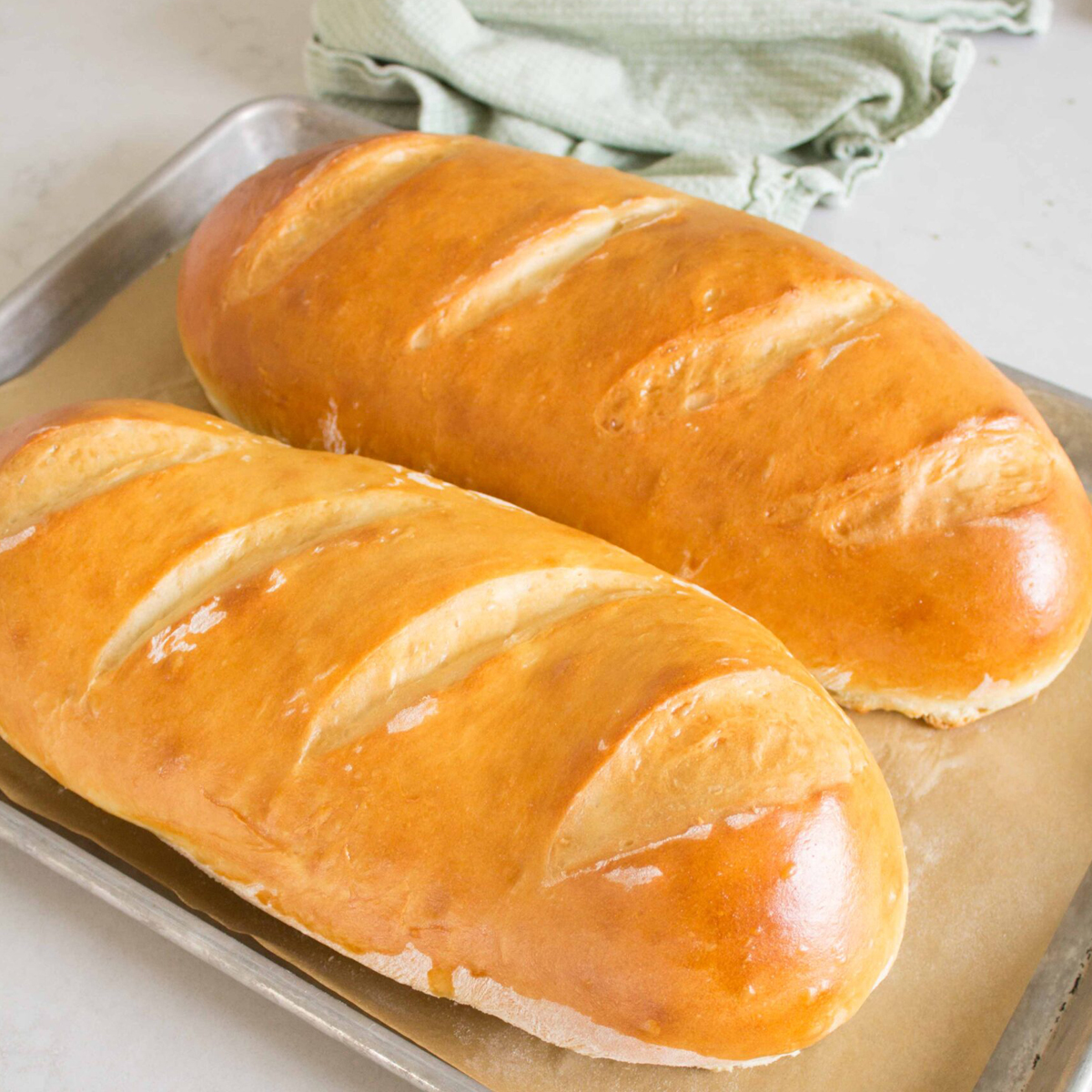Croissants, the buttery and flaky delights that have captured hearts worldwide, are a quintessential French pastry loved by many. These crescent-shaped pastries have a rich history dating back to Austria in the 13th century and were later perfected by French bakers, becoming an iconic symbol of French cuisine.

Made from laminated dough, croissants undergo a labor-intensive process that involves multiple layers of butter and dough, resulting in their distinct flakiness and delicate texture. The magic happens when the croissants rise and bake, creating a golden, crispy exterior with tender, buttery layers on the inside.
The versatility of croissants is another reason for their popularity. Whether enjoyed plain or filled with sweet or savory fillings like chocolate, almond paste, ham, or cheese, croissants offer an array of flavors to suit every palate.
Whether you savor them for breakfast with a cup of coffee, indulge in a midday treat, or include them in a luxurious brunch spread, croissants have a timeless appeal that never fails to enchant. So, let’s delve into the world of croissants and embrace the art of creating these delectable pastries that will leave a lasting impression on your taste buds.
What Is Croissants?
Croissants are a popular type of French pastry known for their distinctive crescent shape, buttery flavor, and flaky texture. They are made from laminated dough, a process that involves layering butter between multiple folds of dough. This technique creates the signature flakiness and lightness that sets croissants apart from other pastries.
The origin of croissants can be traced back to Austria in the 13th century, but they became truly iconic in France during the 19th century. French bakers perfected the art of making croissants, and they quickly became a beloved part of French cuisine.
Traditionally, croissants are enjoyed for breakfast or as a sweet treat with coffee or tea. They are often served plain, but can also be filled with various sweet or savory fillings, such as chocolate, almond paste, ham, cheese, or fruit. The process of making croissants is labor-intensive and requires precision, as achieving the perfect balance of flakiness and buttery flavor is key to creating these delectable pastries.
Today, croissants are enjoyed worldwide, and they continue to be a symbol of French culinary excellence. Whether you indulge in a classic croissant or try a unique flavor combination, these delicate pastries are sure to satisfy your cravings and offer a delightful experience with every bite.
Why You Will Love Croissants Recipe?
- Buttery Flakiness: The croissants’ flaky and buttery layers create a heavenly texture that is unmatched by other pastries. Each bite is a delicate balance of crispy exterior and tender, buttery goodness inside.
- Authentic French Charm: Making croissants at home allows you to experience the authentic charm of French pastry-making. The process of laminating the dough and shaping the croissants gives you a sense of accomplishment and a deeper appreciation for this classic French treat.
- Versatile and Customizable: While classic plain croissants are a delight on their own, you can get creative and customize them to your taste. Fill them with chocolate, almond paste, or your favorite jam for a sweet twist, or go savory with ham and cheese fillings.
- Freshly Baked Aroma: There’s nothing quite like the aroma of freshly baked croissants wafting through your kitchen. The satisfaction of pulling a batch of golden, flaky croissants from the oven is unparalleled.
- Impress Your Guests: Serving homemade croissants is sure to impress your family and friends. These delectable pastries are a show-stopper at brunches, breakfast gatherings, or special occasions, earning you accolades for your baking prowess.
- Comfort Food at Its Best: Enjoying warm, freshly baked croissants with a cup of coffee or tea is a comforting experience that can brighten any morning or lift your spirits at any time of the day.
- A Rewarding Challenge: While making croissants may be a bit more involved than some other baked goods, mastering the technique is a gratifying challenge. As you practice and refine your skills, you’ll achieve a sense of accomplishment and become a skilled croissant baker.
- Endless Possibilities: Once you’ve mastered the basic croissant recipe, you can experiment with different shapes, fillings, and flavor variations to create an array of delectable pastries.
In conclusion, the Croissants offers an exciting culinary adventure that combines artistry, flavors, and textures. With patience and practice, you can create a batch of heavenly croissants that will make you fall in love with this classic French pastry over and over again. So, roll up your sleeves, grab your rolling pin, and let the magic of homemade croissants unfold in your kitchen.

Ingredients You’ll Need
For the Dough:
- 500g (about 4 cups) bread flour (preferably unbleached)
- 10g (about 2 teaspoons) salt
- 75g (about 1/3 cup) granulated sugar
- 10g (about 2 1/2 teaspoons) active dry yeast
- 250ml (about 1 cup) warm milk
- 120g (about 1/2 cup) unsalted butter, melted
For the Butter Block:
- 250g (about 1 cup) unsalted butter, chilled
For the Egg Wash:
- 1 large egg
- 1 tablespoon milk
Optional Additions:
- Chocolate bars or chocolate chips (for chocolate-filled croissants)
- Almond paste (for almond croissants)
- Jam or fruit preserves (for filled croissants)
Equipment Needed:
- Rolling pin
- Baking sheets lined with parchment paper
- Plastic wrap or a large plastic bag for chilling the dough
- Pastry brush
- Sharp knife or pizza cutter
Yield: This recipe yields approximately 16 croissants, depending on the size and shape you choose to make.
Note: The quantities mentioned above are for a classic croissant recipe. Feel free to adjust the recipe based on your preferences, and you can experiment with different fillings to create various croissant variations. Also, the process of making croissants involves multiple steps and requires some patience, but the final result is absolutely worth the effort!
Now that you have all the ingredients and equipment ready, get ready to embark on a delightful journey of making your own homemade croissants. The flaky layers and buttery taste will surely captivate your taste buds and leave you craving for more!

How To Make Croissants
- In a large mixing bowl, combine the bread flour, salt, and granulated sugar. Make a well in the center and add the active dry yeast. Pour the warm milk into the well and stir gently to dissolve the yeast. Let the mixture sit for about 5 minutes to activate the yeast.
- Gradually incorporate the flour mixture into the liquid, and knead the dough until it comes together into a smooth and elastic ball. Cover the dough with plastic wrap and let it rest for about 10 minutes.
- On a lightly floured surface, roll out the dough into a large rectangle, about 1/4 inch thick. Spread the chilled unsalted butter evenly over two-thirds of the dough, leaving one-third without butter.
- Fold the unbuttered third of the dough over the middle third, then fold the buttered third over the top. This creates a “letter fold” or “book fold.”
- Roll out the folded dough again into a large rectangle and repeat the folding process. Cover the dough with plastic wrap and refrigerate for about 30 minutes to chill.
- Repeat the rolling and folding process two more times, chilling the dough between each fold. This creates layers of butter and dough that will give the croissants their flaky texture.
- After the final fold, wrap the dough in plastic wrap and refrigerate overnight or for at least 4-6 hours.
- Preheat your oven to 200°C (390°F).
- On a floured surface, roll out the chilled dough into a large rectangle, about 1/4 inch thick. Use a sharp knife or pizza cutter to cut triangles from the dough.
- Starting at the wide end of each triangle, gently roll the dough towards the tip to form the croissant shape. Place the shaped croissants on baking sheets lined with parchment paper, leaving enough space between them to expand during baking.
- In a small bowl, whisk together the egg and milk to make the egg wash. Brush the egg wash over the tops of the croissants.
- Let the croissants proof at room temperature for about 1-2 hours, or until they have doubled in size.
- Preheat your oven to 200°C (390°F) and bake the croissants for 15-20 minutes or until they are golden brown and puffed up.
- Remove the croissants from the oven and let them cool slightly on wire racks before serving.
Enjoy the flaky and buttery goodness of your homemade croissants! These delightful pastries are perfect for breakfast, brunch, or as a special treat any time of the day. Customize them with your favorite fillings or enjoy them plain – either way, they are sure to be a hit!

How To Serve Croissants
Serving croissants is a delight, and there are various ways to enjoy these flaky pastries. Here are some serving suggestions for your freshly baked croissants:
- Plain Croissants: Enjoy the classic buttery goodness of plain croissants on their own. Serve them warm or at room temperature, and they will still be delicious.
- Croissant Sandwiches: Slice the croissants in half and fill them with your favorite sandwich ingredients like ham, cheese, turkey, lettuce, and tomatoes. The buttery croissant adds an extra layer of flavor and texture to the sandwich.
- Croissant French Toast: If you have some leftover croissants, turn them into a delectable French toast. Dip the croissant halves into beaten eggs and milk mixture and cook them on a griddle until golden brown. Top with powdered sugar, maple syrup, or fresh berries.
- Croissant Bread Pudding: Cube the croissants and use them as a base for a rich and indulgent bread pudding. Mix the croissant cubes with eggs, milk, sugar, and your favorite add-ins like chocolate chips, dried fruits, or nuts. Bake until set and golden brown.
- Croissant Trifle: Layer cubed croissants with whipped cream, fresh fruits, and a drizzle of chocolate or caramel sauce to create a delicious croissant trifle dessert.
- Croissant Ice Cream Sandwich: Slice the croissants in half and fill them with a scoop of your favorite ice cream flavor. This unique twist on ice cream sandwiches is sure to impress.
- Croissant Croutons: Cube the croissants and toast them in the oven until golden and crispy. Use these croissant croutons to top salads or creamy soups for an extra layer of flavor and texture.
Remember that croissants are best enjoyed on the day they are baked. However, if you have some leftovers, you can reheat them in the oven for a few minutes to refresh their flakiness.
Whether you enjoy croissants plain or get creative with various fillings and toppings, these delectable pastries are sure to be a hit at any breakfast, brunch, or afternoon tea gathering.
How To Store Croissants
To keep your croissants fresh and preserve their flakiness, proper storage is essential. Here are some tips on how to store croissants:
- Room Temperature (Short-term Storage): If you plan to consume the croissants within a day or two, you can store them at room temperature. Place the croissants in an airtight container or wrap them tightly with plastic wrap to prevent them from drying out. Make sure the container is large enough to accommodate the croissants without squishing them.
- Freezing (Long-term Storage): To store croissants for an extended period, freezing is the best option. First, allow the croissants to cool completely. Then, individually wrap each croissant in plastic wrap to prevent freezer burn. You can also use freezer-safe resealable bags for this purpose. Properly wrapped croissants can be stored in the freezer for up to 2-3 months.
- Thawing Frozen Croissants: When you’re ready to enjoy the frozen croissants, remove them from the freezer and let them thaw at room temperature. To refresh their flakiness and warm them up, you can reheat the croissants in a preheated oven at 175°C (350°F) for about 5-10 minutes.
- Avoid Refrigeration: Refrigerating croissants is not recommended, as it can cause them to dry out and lose their flakiness. If you have leftovers that you plan to consume within a day, it’s best to store them at room temperature.
- Sealing and Air Exposure: Properly sealing croissants is essential to prevent them from absorbing any unwanted odors from the refrigerator or freezer. Always use airtight containers or plastic wrap to ensure they remain fresh.
- Resist Overheating: When reheating croissants, avoid using a microwave, as it can make them soggy. Instead, use an oven or toaster oven for the best results.
Remember that croissants are at their best when enjoyed fresh, so it’s ideal to consume them shortly after baking. If you have leftovers or plan to store them for later, following the above guidelines will help maintain their delicious taste and texture.

If You Love This Recipe Try These Out!
FAQs and Troubleshooting
Frequently Asked Questions about Croissants:
- Can I freeze croissant dough? Yes, you can freeze croissant dough after shaping it into individual croissants. Place the shaped croissants on a baking sheet and freeze them until firm. Once frozen, transfer them to a resealable freezer bag. When you’re ready to bake, let them thaw in the refrigerator overnight before proofing and baking.
- Can I make croissants ahead of time? Yes, you can make croissants ahead of time and store them. You can freeze baked croissants and reheat them when needed, or you can freeze the unbaked shaped croissants and bake them later. Follow the storage instructions mentioned earlier for best results.
- Can I use margarine instead of butter for croissants? While butter is the traditional choice for croissants and provides the best flavor and texture, you can use a high-quality margarine with a high-fat content as a substitute. Keep in mind that the flavor and texture may be slightly different from those made with real butter.
- How do I achieve a flaky texture in croissants? Achieving a flaky texture in croissants requires proper lamination (layering) of the dough with butter. Make sure to use cold butter and fold the dough properly during the rolling and folding process. This creates distinct layers that puff up during baking, resulting in the characteristic flakiness.
Troubleshooting Common Croissant Issues:
- Croissants didn’t rise or puff up during baking: This could be due to insufficient proofing time or using expired yeast. Ensure that your yeast is fresh and active, and allow enough time for the croissants to proof and double in size before baking.
- Croissants are too doughy or dense: Overproofing the croissants can lead to a dense and doughy texture. Follow the proofing times in the recipe and avoid letting the dough rise for too long.
- Croissants are too greasy: If the croissants turn out too greasy, it may be because the butter leaked during baking. Ensure that the butter block is properly enclosed in the dough during the rolling and folding process.
- Croissants are too dark or burnt: To prevent croissants from browning too quickly, you can cover them with aluminum foil during the latter part of the baking process. Also, check your oven temperature to ensure it is accurate.
- Croissants have a strong yeast flavor: If your croissants have a strong yeast taste, it’s possible that too much yeast was used. Adjust the yeast quantity in the recipe or reduce the fermentation time to balance the flavors.
Remember that making perfect croissants may take some practice and patience. Don’t get discouraged by any initial challenges and keep experimenting until you achieve the flaky, buttery, and delicious croissants you desire. Enjoy the process of baking these delightful treats!

Note About Croissants
Welcome to the world of croissants, where buttery layers and flaky textures create an indulgent treat! Making croissants from scratch is a delightful and rewarding experience that requires some time and patience, but the results are truly worth it. Here are some essential tips and reminders to help you on your croissant-baking journey:
- Preparation is Key: Ensure all your ingredients are measured accurately, and follow the steps carefully. Proper preparation guarantees the best outcome.
- Temperature Matters: Pay attention to temperatures during the process. Cold butter and chilled dough are crucial for achieving those beautiful layers.
- Time and Patience: Croissants require multiple rounds of rolling and folding, known as lamination. Give the dough enough time to rest and chill between folds to develop the flaky texture.
- High-Quality Ingredients: Use the best-quality butter and flour you can find for the tastiest croissants.
- Customize Your Croissants: Get creative with fillings and shapes. From classic plain croissants to chocolate-filled or almond variations, there are endless possibilities.
- Perfecting Takes Time: Don’t be disheartened if your first attempt isn’t flawless. Croissants can be finicky, and practice makes perfect.
- Enjoy the Process: Embrace the joy of baking and enjoy the aroma of freshly baked croissants filling your kitchen.
With these tips in mind, you’re ready to embark on a croissant-baking adventure. Whether you’re a novice or seasoned baker, the journey of creating flaky and delicious croissants is truly a labor of love. Savor each buttery bite and share the joy of your homemade croissants with family and friends. Happy baking!
Nutrition Information
Nutrition information for Croissants can vary based on the recipe and size of the croissants. Here is a general overview of the approximate nutritional values for a standard-sized plain croissant (about 62 grams):
Calories: 231 kcal, Total Fat: 12.8g, Saturated Fat: 7.8g, Trans Fat: 0g, Cholesterol: 32mg, Sodium: 266mg, Total Carbohydrates: 25.6g, Dietary Fiber: 0.9g, Sugars: 3.5g, Protein: 4.5g
Please note that these values are approximate and can vary depending on the specific ingredients and preparation methods used. Additionally, if you add fillings like chocolate or almond paste, the nutritional values will change accordingly. If you’re following a specific diet or have dietary restrictions, it’s essential to consider these nutritional values when enjoying croissants. Moderation is key, as croissants are a treat best enjoyed in moderation as part of a balanced diet.





